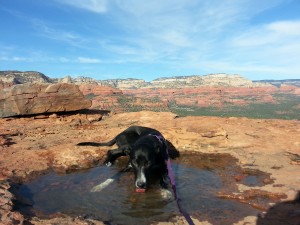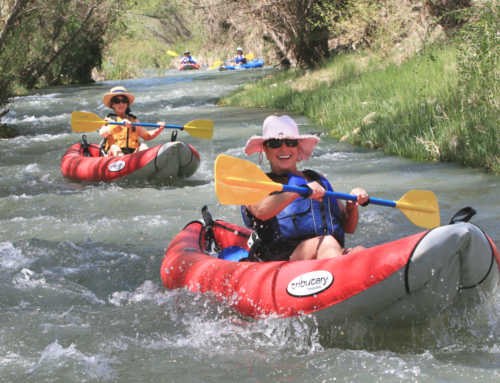The Dos and Don’ts of Hiking with Your Dog
At El Portal Sedona Hotel, we rarely do this – have a guest blogger. But this is so up our alley, we just had to have Jen of Your Dog Advisor be our guest. We write about pet-friendly, family friendly, rules of hiking, but not about hiking with your dog, so we hope you enjoy this, and maybe even glean a thing or two from it…
6 Tips for Hiking With Your Dog
Learning from your mistakes is important, but being proactive is better– especially for the sake of your pet. We will cover the do’s and don’ts of hiking with your dog, as well as some important information you need to know before hitting the trail with your furry friend to keep you legal and both of you safe.
Watch Your Dog Carefully While You Hike
With a few exceptions that we will discuss later, most dogs will outperform you in conditions you wouldn’t bear with less preparation and no gear. Your dog is tough, and they know it. Unfortunately, this toughness can get your dog in some serious trouble.
You must understand that your dog can do no more than bark, stare, and possibly paw at you for its needs. It is up to you, the owner, to keep track, take note, and read your dog and its condition. It is also up to you to be prepared for both yourself and your dog as a lack of preparation can lead to some serious problems.
This was made evident one hot Idaho summer as my husband, our Blue Heeler Pointer mix, and I set out on a round-trip hike that blew past the planned distance and traversed a face in constant exposure to the sun with no shade to be found. Though we kept the three of us well hydrated, we could feel the heat taking its toll and realized we would soon run out of water. Dehydration was quickly setting in as we be-lined our way towards the trailhead.
The simple mistake of not planning our trail properly and not bringing enough water resulted in a situation that could have ended a lot worse than it did. Do your due diligence and double-check. A few pounds more water is better than a few pounds less and a bad scenario.
It is also good to pack enough food for you and your dog. Let the extra weight in your pack remind you that your dog’s life is in your hands. And always remember that if you are tight on space in your pack, water will always be more important than food. Though it can be uncomfortable, running out of food is not nearly as crucial as running out of water; as your dog can function and even thrive while in a temporarily fasted state.
Consider Your Dogs Age When Planning Your Hike
Although your pup is tough, some dogs may have exhausted that toughness in the earlier years of their lives. Old dogs need to be looked after with a keen eye when hiking. Hip dysplasia, arthritis, joint and muscle injury, and other medical problems are far more prominent in an elderly canine, especially for those that are predisposed to certain health complications.
This doesn’t mean you shouldn’t bring your senior pup out on the trail with you. Exercise and the outdoors are two of the best things for a dog who is long in the tooth. Being a dog parent means finding the line between overworking old joints, and pushing your pup to stay strong. As previously stated, watch your dog like a hawk.
Oftentimes, issues can go unnoticed as your dog will power right through fueled by the love of the trail. By walking behind your pet and letting them live their best life on the trail, you can gauge their comfort level by their speed and frequency of stopping. You should also be on the lookout for uneven stepping patterns and any limps that may occur indicating a condition that should be looked at.
Keep your granddog trotting on through the years. Find hikes that do not have too much incline and decline and are on stable grounds. Boulder hopping, shale scrambles, and steep root sections should be substituted for nice loam walks to the lake, one with good stream stops along the way are the best!
You should also lighten the load of your dog’s pack, should they have one, or just bear the load yourself. This keeps your dog moving naturally and keeps excess weight off the joints. Just keep a keen eye and encourage your dog, making for the happiest of their elder years. Let them have the satisfaction of being out front and guiding you along. Like they say in the islands of Malaysia, “You happy, me happy!”
Make Sure Your Dog is Trained and Well-Tempered
You’re going to want to consider the behavior and personality of your pet. If your dog is aggressive around other dogs or people, it is especially important that you select your location wisely. Many folks have dogs that are rescues and are undergoing a change in their lives. However, many of these dogs never fully break their old habits and can be very jumpy with the potential for aggression.
These dogs need the therapy of hiking, but it can be a challenge. Find hikes and locations that are out and away from people and other animals. Have adequate solitude for these dogs to get in their zone and exhaust some energy and tension. Feed them a new purpose as they trek on without the possibility of any harm being inflicted.
Note that a dangerous and violent dog that has not yet been mastered enough to be under reasonable control should not be taken out into public. If you are wary of conflict breaking out between your dog and another person or dog, take many precautions to ensure you hike alone in a location unvisited by common day hikers. All dogs deserve a chance, but it takes diligence to prevent possible physical and legal dilemmas.
Know the Laws of the Lands
The canine is a beautiful creature that commands a connection with nature and a chance to live out instinctual purpose. Though your dog lives only by the laws of nature and physics, you, the owner, live in a world of order and regulation.
I’ve got some rough news, many lands that are legal for you may not always be legal for your dog. If you are planning your dream hike through one of the wonders of the world with your pup, you may have to reschedule.
National parks offer some of the most epic hikes one can find, as they preserve incredible lands and protect them from industrialization, overcrowding, and the imbalanced influx of species that can become disruptive. Unfortunately, the common house dog can pose a threat to this pristine balance found in national parks.
Hiking trails found in the national parks are off-limits to dogs. The only exceptions are for those participating in thru-hikes like the Pacific Crest Trail that intertwine with the Parks. Don’t scrap the whole trip to the park just yet. Car campsites and day-use areas are perfectly fine to bring your dog as long as the parks’ leash requirements are met (a leash no longer than 6ft, unless otherwise posted). This lets you and yours enjoy some of the most beautiful environments while not disrupting the natural order. Just don’t plan on getting in any day hikes as leaving your dog in the car and at camp can be a real issue.
Outside National Parks
With National Park treks out of the hiking scope, there is still a nearly infinite amount of exploring to be done alongside your dog. The majority of dog-friendly hikes will probably be found at your local state parks and national forests. Here, dogs are usually welcomed and will likely get the chance to encounter other peak-bound pups.
Here in Washington state, I often use the Washington Trails Association website to find dog-friendly trails. There are many other sites like this one that apply in different states, just do a quick Google search and you will find information about trails in your area and the laws that surround them. These sites give you great information about the difficulty of the hike, distance, GPS directions, and pictures. Some sites even include up-to-date trail reports from real people who have been hiking the trail recently!
Luckily, most state parks allow you to bring your dog on the trail, but leash laws vary state by state; Arizona – leash required – 6-foot max leash.
Pack the Right Gear in Your Pack and Your Dog’s
As the previous tale indicates, when hiking with a dog it is so crucial to be prepared. As self-sufficient as dogs can be, they really depend on you to keep them safe, fed, and hydrated. You should make sure you have the gear you need with you for the extent of time you will be out, and plan for errors.
Along with supplying yourselves with plenty of water and a healthy choice of edible energy, you want to bring some sort of drinking apparatus for your pet. You can find some really cool collapsable ones at R.E.I., but you can also roll the edges of a plastic sandwich bag to make a nice bowl for your dog that weighs virtually nothing. Just keep a few in your pack or your dog’s pack. Besides, any lightweight backpacker knows just how incredible the zip-lock can be for a number of outdoor living situations.
A healthy, fit, and spry juvenile or adult dog is capable of wearing their own pack. However, if you chose to rig your dog with one of these radical tactical vests, there is some key things that should be done on your part.
First of all, make sure your dog is capable of carrying weight. We already mentioned that old dogs and those with medical limitations may have some trouble with this. A younger athlete of a dog will fair much better carrying loads like their own bottle of water.
If you feel comfortable with a pack on your dog, the next step you need to take is sizing your dog accordingly. Although websites can help you gauge pack sizes by your dog’s age, breed, height and length, there is no better way to size your dog than trying packs on.
Packs are a great way to get a little load off your back by having your buddy build some muscle. But you must be careful; packs should never be overloaded. Always weigh the total weight of your dog’s pack when it is fully loaded, and ensure that it never exceeds 15% of your dog’s total weight. Also, ensure it is properly fastened and not over tightened as this can lead to excess pressure on your dog’s chest and ribs. Finally, never use a heavyweight pack that will cause your dog to become hot in high temperatures.
Other items useful for your trail dog may be a set of shoes. Although it may seem comical to some, dog shoes can really save your puppy’s paws if they are tasked to climb up shale with you and can offer protection from burns on hot sand or cement as well as mittens if you hike across a lot of ice.
You should also be sure to include in either your dog’s pack or yours, poop bag, glowstick or collar lamp for night treks, and a lightweight leash with a carabiner to make clipping up easy and is endlessly useful if your dog is a runner off-leash.
Hope for the Best, Prepare for the Worst
No one ever wants to think about their babies getting hurt, and even less, do people plan on what to do in the case that does actually happen. As resilient as dogs can be, they are still susceptible to getting injured. In the last 2 years I have had to take my own dog to the vet three times from hiking injuries; trust me, folks, it happens much easier than you would think.
There are ways to prevent injuries from happening, such as making sure that your dog doesn’t jump down to or on to anything sharp, keeping them a safe distance from drops and ledges, and training them to not overstep their boundaries by establishing call commands that halt them. Now, what do you do when or if an injury does occur on the trail? In addition to the items you should pack with you, you should pack a few rolls of bandages, some isopropyl alcohol, and a few sticks found on the trail. Here are a few steps to take if an injury happens:
- Don’t panic
- Assess the damage
- Treat the injury as best as you can from where you are
- If at all possible, carry your dog
- Treat as best as you can from your vehicle
- Take them to the vet if necessary
You’ve done your research, found your trail, packed all the supplies, and planned for the worst– you’re ready! Now it’s time for the most important step out of them all, enjoying the sights, sounds, and overwhelming beauty of nature alongside your furry best friend.
Getting out into nature is so important in order to decompress from our sometimes stressful, monotonous lives, and bringing your pet is a great way to unwind, bond, and enjoy the beauty this world has to offer. Happy hiking to you and your best friend!
At El Portal Sedona Hotel, Sedona’s pet-friendliest hotel, we want to thank Jen at Your Dog Advisor
for these insightful and helpful tips!
El Portal Sedona Hotel 1.800.313.0017









Leave A Comment